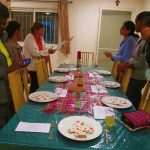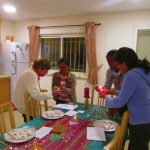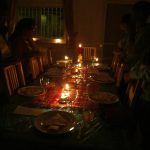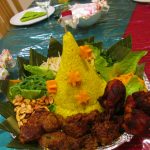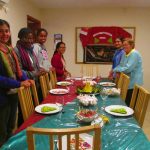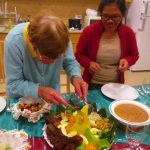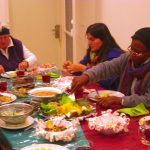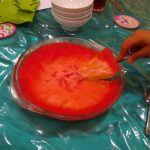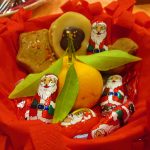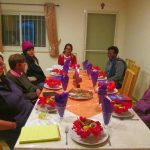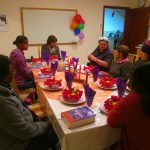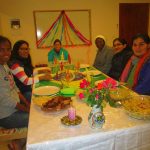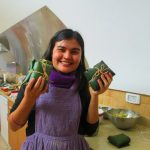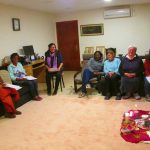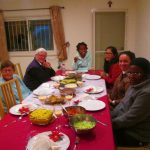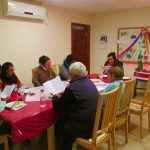Ireland
We have had special celebrations every week since November, each one preparing and explaining how we live and celebrate Christmas in our countries. The first one was Sr. Collette, who prepared a beautiful prayer and delicious Irish food on 22nd November. She mentioned that people usually put candles in the window to show the way to people and also, they usually had a family dinner. We really enjoyed the sharing of Sr. Collette and how her family was together at Christmas time. We ask the Lord for Sr. Collette’s family to give them peace, joy and love.
Indonesia
On November 28th, our second Christmas story was from Indonesia. Although Christmas is considered to be adopted from the Western tradition, yet, the vastness of Indonesian archipelago tells the richness of its traditions and cultures and how Christmas is celebrated in different provinces or islands. Today, as Maria shows Indonesian map, she shares with us nine different traditions of its major islands and particularly from her own place, North Sumatera where the people normally live in a very communitarian way. This time of Christmas, each family in the village used to save money and collect it together to buy a cow or buffalo so that they can celebrate Christmas together. They came and shared the meals together. During this Christmas up to the New Year’s Eve, the youth would stay up late and go caroling from house to house. The caroling would start from one house to the next and the group becomes larger as they continue singing from one house to the next.
Maria cooked one of the well-known dishes called “nasi tumpeng”, which people would most of the time have for a thanksgiving celebration. This particular dish is from Java Island which significantly describes the geographic context of Indonesia. “Nasi tumpeng” is rice formed in a cone shape or of a mountain with different vegetables and meat around the rice. Though “nasi tumpeng” is not very well known internationally, it is symbolically significant in representing Indonesia’s culinary with its simplicity. This traditional dish, as Maria explained, provides a deeper insight into the core concept of “nasi tumpeng” as a ritual feast in terms of its aesthetic, value, function and meaning. “Nasi tumpeng” has more meaning than simply a meal or a recipe. With “nasi tumpeng”, people express their gratitude to God, and appreciate the unity and harmony among them.
So, we have enjoyed the evening having a taste of Indonesian food and a cultural Christmas celebration.
Austria
 Christmas in Austria begins when we light the first candle on our Advent wreath . Advent is the period of preparation for the festival honouring the birth of Christ. In the streets we find Christmas markets, hot spicy wine to drink and the smell of the special Christmas cookies fills our houses. In some parts of Austria the crib („Bethlehem“) is the centre of the house decoration, in others it is the Christmas tree which is decorated with gold and silver ornaments or stars made out of straw, and sweets and candy wrapped in tinfoil. During Advent families pray, read Christmas stories or sing carols together.
Christmas in Austria begins when we light the first candle on our Advent wreath . Advent is the period of preparation for the festival honouring the birth of Christ. In the streets we find Christmas markets, hot spicy wine to drink and the smell of the special Christmas cookies fills our houses. In some parts of Austria the crib („Bethlehem“) is the centre of the house decoration, in others it is the Christmas tree which is decorated with gold and silver ornaments or stars made out of straw, and sweets and candy wrapped in tinfoil. During Advent families pray, read Christmas stories or sing carols together.
Christmas Eve (December 24th) the whole family gathers to sing Christmas carols. “Silent Night, Holy Night,” written and performed for the first time on December 24th, 1818, by Josef Mohr and Franz Gruber in the Upperaustrian village of Oberndorf (close to the village where Sr. Juliana grew up), is still the favourite Christmas carol. Presents are placed under the tree or in front of the crib and young children believe that they were brought to them as a reward for good behavior, by the Christ Child (Christkind). Austrian Christmas tradition has it that it is the Christ Child himself which brings, on Christmas Eve, the children their Christmas presents, and it is to Christ Child that their letters and wish lists are addressed in the weeks before Christmas. Christmas Eve (24th of December) is more important in Austria than Christmas Day. After (Christmette) the midnight service usually ends with candlelight singing “Silent Night, Holy Night”. Christmas is traditionally celebrated with the family.
Brazil
 On Dec 12, we had a Brazilian Christmas sharing with special songs and a meal. Our happy day started early in the morning with the preparation of the Brazilian meal – pork, salpicão (cold salad), rice, shrimp moqueca (shrimp cooked with coconut milk) and hot wine and the room beautifully decorated.
On Dec 12, we had a Brazilian Christmas sharing with special songs and a meal. Our happy day started early in the morning with the preparation of the Brazilian meal – pork, salpicão (cold salad), rice, shrimp moqueca (shrimp cooked with coconut milk) and hot wine and the room beautifully decorated.
Our focus was to share how we celebrate Christmas in our family and community in Brazil. Ivone prepared a beautiful prayer and then we followed with a small video with Brazilian children expressing what Christmas means to them. Ivone and Lucia made a “play-talked – with questions and answers” to explain some Brazilian Christmas foods and traditions. After that we enjoyed a delicious dinner.
Costa Rica
 On December the 22th we had a nice evening celebrating Costa Rican Christmas. We began with the traditional Posada song, Christmas caroling. Some of us (the Pilgrims) were outside the house as Mary and Joseph did when they were searching for a place for Mary to give birth. After it we prayed offering some petitions for our countries. We also enjoyed Costa Rican typical food like: Patacones (plantain), Rompope (drink), empanadas, Pico de Gallo (kind of salad), frijoles molidos (beans), rice, tamales and Tamal asado (made from corn flour) and fajitas de res (beef). Andrea and Nancy were so happy to share with our community and with Andrea, a volunteer from Sant Vicent who is from Guatemala. We ended the evening singing Christmas Carols.
On December the 22th we had a nice evening celebrating Costa Rican Christmas. We began with the traditional Posada song, Christmas caroling. Some of us (the Pilgrims) were outside the house as Mary and Joseph did when they were searching for a place for Mary to give birth. After it we prayed offering some petitions for our countries. We also enjoyed Costa Rican typical food like: Patacones (plantain), Rompope (drink), empanadas, Pico de Gallo (kind of salad), frijoles molidos (beans), rice, tamales and Tamal asado (made from corn flour) and fajitas de res (beef). Andrea and Nancy were so happy to share with our community and with Andrea, a volunteer from Sant Vicent who is from Guatemala. We ended the evening singing Christmas Carols.
Written by Andrea, Maria, Sr. Juliana, Lucia and Nancy.
Congregational Novitiate Ein Karem, Jerusalem

